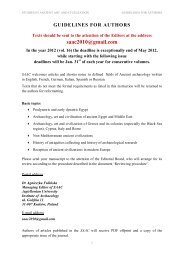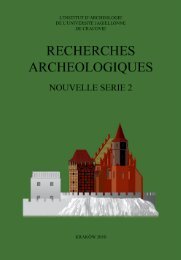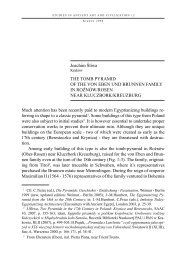l'institut d'archeologie de l'universite jagellonne de cracovie ...
l'institut d'archeologie de l'universite jagellonne de cracovie ...
l'institut d'archeologie de l'universite jagellonne de cracovie ...
Create successful ePaper yourself
Turn your PDF publications into a flip-book with our unique Google optimized e-Paper software.
Excavations of the Western Kom at Tell el-Farkha in 2006<br />
visibly parted in the middle of the disproportionately<br />
large head and reach the half<br />
of the back. The very damaged face bears<br />
traces of plastic mo<strong>de</strong>ling: large, almondshaped<br />
eyes, small nose and narrow lips,<br />
that clearly fall down. A hole in the basis<br />
(0.3 cm in diameter). Badly preserved, the<br />
left arm is missing, major losses on the surface,<br />
numerous irremovable lumps of soil<br />
and salt. Hippopotamus tusk. Total height<br />
4.7 cm. Height of the basis 1.1 cm. Inv. no.<br />
W06/8 (R-666).<br />
2. Woman (Fig. 33). A badly preserved representation<br />
of a standing, naked woman. Her<br />
right hand falls along the body, the left one<br />
is bent in elbow and holds breasts. Buttocks<br />
and womb are plastically mo<strong>de</strong>led. At the<br />
back of the head hair reach her shoul<strong>de</strong>rs.<br />
Badly preserved: lack of legs and the left<br />
arm, face is completely effaced. Numerous<br />
losses, lumps of soil and salt on the whole<br />
surface. Hippopotamus tusk. Height as preserved<br />
3.0 cm. Inv. no W06/7 (R-665).<br />
3. Mo<strong>de</strong>l of chair/bed leg in form of bovine<br />
leg. It supports on a relatively high “hoof”<br />
with horizontal notches. Its upper part is<br />
flat and has an asymmetric hole presumably<br />
meant for attaching the leg with the chair/<br />
bed’s beam. The object is well preserved<br />
<strong>de</strong>spite irremovable lumps of soil and salt.<br />
Hippopotamus tusk. Height 3.8 cm. Inv. no.<br />
W06/5 (R-663).<br />
4. Box lid. The surface is damaged with<br />
irremovable dirt. Hippopotamus tusk.<br />
Measurements 4.8×2.7×1 cm. Inv. no W06/6<br />
(R-664).<br />
5. Faience slab. An object shaped as a<br />
slightly curved cuboid. Obliquely bored<br />
holes in its shorter si<strong>de</strong>s. A <strong>de</strong>coration in<br />
form of a plaited belt is placed at one of<br />
the longer si<strong>de</strong>s of the object. The item<br />
was found in one of stone vessels discovered<br />
in the vicinity of the <strong>de</strong>posit. Faience.<br />
Measurements 7.7×1.0×0.9 cm. Inv. no.<br />
W06/4 (R-662)<br />
439<br />
The above <strong>de</strong>scribed second <strong>de</strong>posit from<br />
Tell el-Farkha belongs to the most important<br />
among the recently discovered in Egypt<br />
ones. Till the beginnings of the Polish excavations<br />
in Tell el-Farkha from the Delta<br />
area the only known were from Tell Ibrahim<br />
Awad. However, they were only very preliminary<br />
<strong>de</strong>scribed (van Haarlem 1995; 1996;<br />
Belowa, Sherkova 2002). But still it may<br />
be stated that – concerning their quality and<br />
variety of objects – sets from the Delta do<br />
not give way to other <strong>de</strong>posits known from<br />
Upper Egypt: from Hierakonpolis (Quibell,<br />
Petrie 1900), Abydos (Petrie 1902; 1903;<br />
Kemp 1968) or Elephantine (Dreyer 1986).<br />
The latter are far more better worked out<br />
and known, although research on the most<br />
famous <strong>de</strong>posit from Hierakonpolis are still<br />
in progress, resulting in recently surprising<br />
and even amazing findings (Whitehouse<br />
2002; 2004).<br />
Most objects from the Tell el-Farkha <strong>de</strong>posit<br />
could not stand in<strong>de</strong>pen<strong>de</strong>ntly. Some<br />
figurines are at their bottom end wedge-like<br />
shaped, probably to facilitate their placing<br />
in specially prepared holes in a larger base<br />
or even fastening right into sand or mud.<br />
Other stand on small round, oval or quadrangular<br />
bases that were drilled from their<br />
bottom si<strong>de</strong> into relatively <strong>de</strong>ep holes allowing<br />
their attaching on pins of bone or wood<br />
(see cat. no. I.G.2). Sporadically, there are<br />
some objects thoroughly drilled to hang<br />
them on something or fasten onto some flat<br />
surface.<br />
Preliminary analyzing the Tell el-Farkha<br />
<strong>de</strong>posit, attention should be drawn on the<br />
wi<strong>de</strong> variety of the <strong>de</strong>posit elements from<br />
the both stylistic and formal point of view.<br />
At first sight, it seems that the majority of<br />
the figurines should have their counterparts<br />
in previously discovered sets. More <strong>de</strong>tailed<br />
examination enables to state that many types<br />
of figures were hitherto absent in the Egyptian<br />
art. Similarity to others it is superficial





